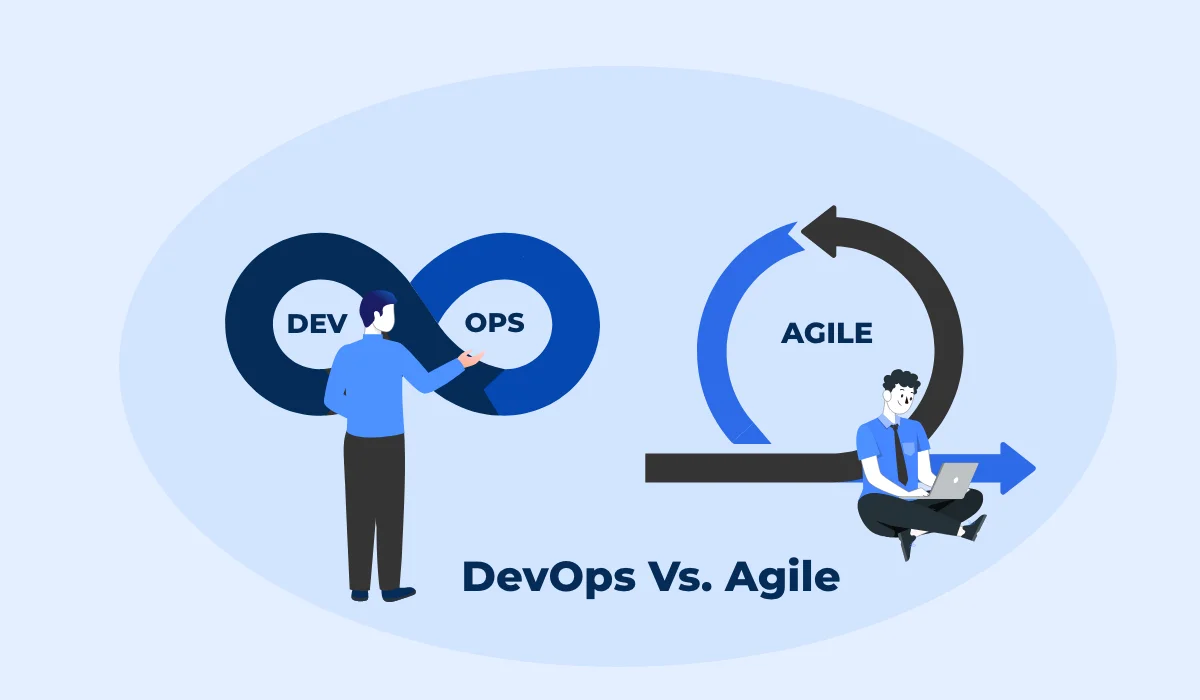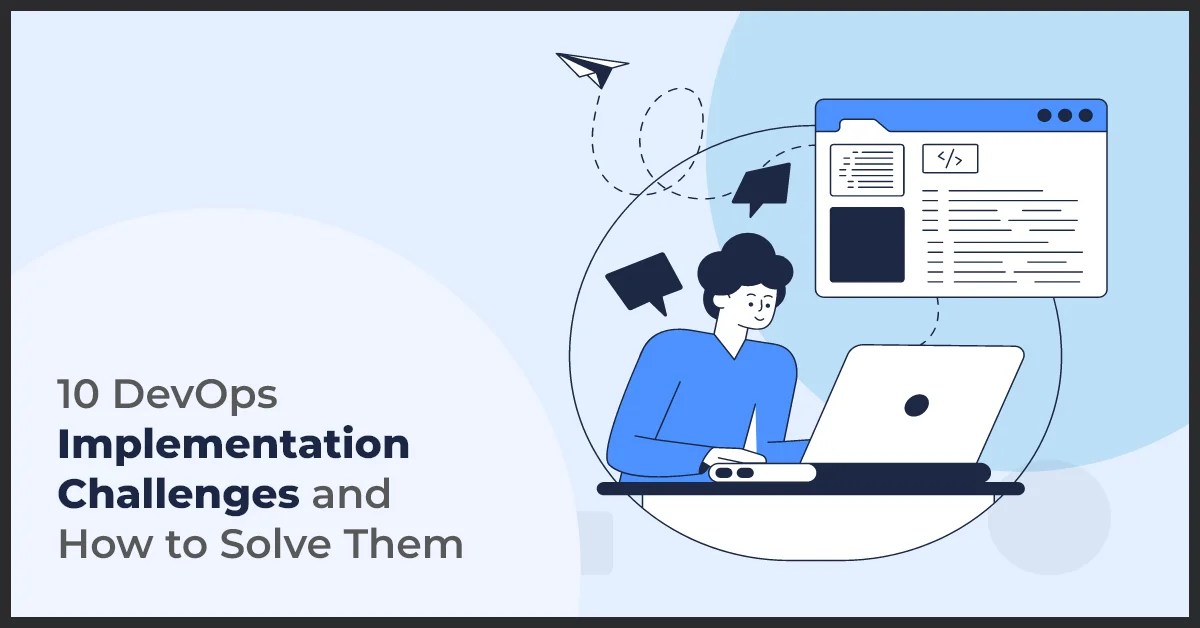Head-to-Head Comparison: DevOps Vs. Agile

Published on: November 3, 2022
Updated on: July 05, 2024
763 Views
- Devops
9 min read
Software development as we know it today has come a long way. During its evolution emerged three critical milestones:
- The waterfall method focuses on the time needed for a product release.
- Then came agile methodology, which focuses on optimizing the development life-cycle.
- And the most recent, DevOps, aims to combine development and operations to boost productivity, enhance collaboration, and deliver better products.
Adopting DevOps and Agile practices requires a deep understanding of the differences and similarities between these two and when they can work together.
In this blog, we'll explain all this and a lot more. But before we do that, let us add some context by defining them.
What Is Agile?
Agile is a software development methodology introduced in 2001 as an alternative to the waterfall approach. This approach focuses on continuously delivering small manageable product increments that align with trends and customer needs. It is known for its linear, structured, and sequential life cycle.
In Agile, the product is enhanced through iterative development and testing. Unlike the inflexible waterfall methodology, agile is an effective way to manage a complex project and improve communication and collaboration between internal and external stakeholders.
What Is DevOps?
DevOps is a software development practice that brings together people, operations, and technology. Its goal is to improve collaboration and productivity and deliver quality software. It comprises a continuous cycle of creating, testing, deploying, and monitoring releases.
DevOps also includes implementing its principles and deploying DevOps tools for testing.
Top 3 Differences Between Agile and DevOps
1. Agile Values Vs. DevOps Principles
Agile Values
Agile working is based on 12 principles as defined by the Agile Manifesto. However, at the heart of agile software development lies four core values. These are:
1. Prioritize Individuals and Communication Over Processes and Tools
A successful agile approach prioritizes each team member and emphasizes the need for a healthy and stimulating work environment. It propagates constant team communication to keep everyone involved throughout the development process and drive maximum efficiency.
2. Prioritize Working Software Over Exhaustive Documentation
Documentation of requirements and expectations during software development can be a tedious process that can delay the start of any project. It is painstaking, becomes a bottleneck, and is often altered later as the customer's needs change. Therefore, the agile approach encourages spending less time on documentation and more time on embracing changes.
3. Prioritize Client Collaboration Over Contract Negotiation
Iterative development involves communicating and collaborating with customers regularly. Incorporating immediate customer feedback steers the project in a direction that meets the client's expectations and delivers the best results.
However, companies often spend a lot of time negotiating the contract with clients before starting development and refer back to the agreement after production. This causes potential miscommunication and should be avoided when following the agile approach.
4. Prioritize Responding to Change Over a Predefined Plan
One of the significant differences between Waterfall and Agile is responding to changes. Changes made during the middle of a project need to be addressed for the product's overall success. Quickly adapting to new circumstances and responding to changes are the cornerstone of the Agile methodology.
DevOps Principles
A lot of companies are transitioning to DevOps. And there's a reason behind that. Implementing DevOps has multiple benefits, including quick and integrated software deployments.
While transitioning to DevOps, engineering processes need to understand the fundamental values that drive it. Presenting the top principles of a DevOps environment:
1. Version Control. Developers submit any changes in the code to the master repository or master branch multiple times a day. These codes are verified before submission, and other developers can monitor all the changes to foster collaboration.
2. Continuous Integration. The development team integrates its code multiple times a day. Each team member breaks the tasks into small, manageable codes to quickly identify potential bugs and merge conflicts.
3. Continuous Delivery. Small changes ensure quicker update releases for higher customer satisfaction. The continuous integration of code with a shared repository ensures the code is also delivered to the user.
4. Continuous Deployment. A huge part of DevOps is focused on automating processes to increase production. This principle involves automating minor updates' releases. Minor updates are the ones that do not pose a threat to the existing architecture.
5. Continuous Testing. This principle involves testing at each step of software development. Developers usually automate tests to get insightful feedback and a process risk assessment.
6. Continuous Operations. The developer team continuously works towards upgrading software with minor but frequent releases. It requires continuous performance monitoring to avoid downtime during code release.
7. Collaboration. DevOps encourages collaboration and feedback sharing between the development and operations teams. It propagates proactive communication and feedback exchange for maintaining an efficient DevOps pipeline.
2. DevOps Vs. Agile Software Development
Agile Software Development
Agile software development requires the implementation of agile frameworks, including Scrum and Kanban. Any agile software development life-cycle starts by splitting the entire project into manageable requirements. The tasks are organized into sprints.
During the sprints, all the involved teams work on a specific task or feature of the project. The team builds, tests, and deploys software, tweaking it along with way. Once the sprint is over, the team works on the following tasks until the project is finished.
These sprints ensure continuous product development and delivery. It also ensures customers, project managers, and other stakeholders are updated and provides timely feedback for the best outcomes.
DevOps Software Development
Software development through DevOps emphasizes an established pipeline that the project needs to pass through. The pipeline's number of stages varies depending on the software being developed and the project's complexity.
In most cases, there are four key stages of DevOps software development: develop, build, test, and deploy. Usually, a planning step precedes these four stages, and a monitoring step is added after deployment.
3. Top Agile Vs. DevOps Features
Top Features of Agile
1. Workflow Productivity Tools
Agile includes different planning tools like Kanban and Scrum to track progress and organize requirements and tasks.
2. Incremental Progress
It creates a consistent development cadence by using time-boxed production methods and sprints.
3. Needs of the Customer
Agile has a fail-fast, fail-early approach to constantly improve and ensure a feedback loop that keeps clients' expectations on the top.
Top Features of DevOps
1. Broader Scope, Wider Reach
DevOps focuses on all the stages of software development and delivery to ensure faster and more reliable releases.
2. Inter-Department Collaboration
It fosters a culture that reduces team friction and promotes cross-functional teamwork to create effective teams and a better work environment.
3. Promotes Automation to Drive Efficiency
The DevOps practice tries to identify opportunities to create automated processes and workflows wherever possible to drive efficiency.
Top 3 Similarities Between DevOps and Agile
1. Testing and Automation
Both DevOps and Agile focus on achieving stability. They achieve this by routinely integrating testing. Both methodologies rely on automation to be more flexible and safer during execution.
2. Inclination Toward Business Productivity
DevOps and Agile have one common goal: deliver releases while maximizing productivity. Using Agile in software development allows teams to focus only on a single target and be more productive. Similarly, DevOps creates a culture that results in quicker releases and delivery without impacting business processes.
3. Inspired by Lean Philosophies
DevOps and Agile derive their methodologies from the Lean philosophy, which helps them standardize communication and facilitate smooth team interactions. They believe in creating a healthy and productive environment with continuous feedback and open communication.
Combining Agile and DevOps
Combining Agile and DevOps has multiple benefits, like faster delivery, better user satisfaction, and effective team collaboration. Despite these advantages, merging the agile culture with DevOps practices is easier said than done. It requires transforming existing attitudes and strategies. Let's find out how:
How DevOps and Agile Can Work Together
A common goal of both Agile and DevOps is to deliver quality software in a given timeframe. They both speed up software delivery. The difference between the two is that agile emphasizes optimizing the software development life.
cycle, while DevOps focuses on bringing together developers and operations in a CI/CD environment. Despite this glaring difference, both these approaches are not mutually exclusive.
In other words, you don't have to choose between the two. Combining these two software development approaches will lead to reliable outcomes and higher efficiency.
You can take advantage of Agile's frameworks for organizing work, including Kanban and Scrum, while using DevOps to drive a culture of collaboration to achieve the end goal. So, if your organization is transitioning towards DevOps, you can still leverage Agile's existing workflows.
Why Combine DevOps with Agile?
Here's how the integration of DevOps and Agile helps:
- It improves software development and streamlines the release process.
- It encourages better collaboration and increases visibility.
- It ensures more value and fewer risks with each release.
- It also leads to faster fixes and fewer bugs.
- It results in higher user satisfaction rates.
In a Nutshell
Though both DevOps and Agile are different approaches, they share the same goal: to enhance the speed and quality of software development. How you want them to work—either separately or together—is totally up to your team and processes.
Many teams have found Agile to help them significantly, while others have not realized all the benefits promised by this approach. It's the same with DevOps.
Therefore, discarding one for another may not be the best option. Maybe incorporating both can fill the gaps for companies struggling with Agile or DevOps and help achieve the success they deserve. If you need help implementing any or both of these strategies in combination with each other, write to us at info@growthnatives.com today.
Frequently Asked Questions
It is challenging to compare Agile and DevOps directly as better or worse as they serve different purposes. Agile focuses on iterative development and collaboration, while DevOps emphasizes collaboration between development and operations teams to streamline software delivery.
Benefits of DevOps over Agile include:
- Faster deployment
- Improved collaboration
- Continuous feedback
Choosing DevOps over Agile depends on the organization’s specific needs and goals. DevOps is suitable for environments where rapid and frequent software releases are necessary, and close collaboration between development and operations is essential for success.
The DevOps lifecycle consists of several phases, including:
- Plan
- Code
- Build.
- Test
- Deploy
- Operate
- Monitor

